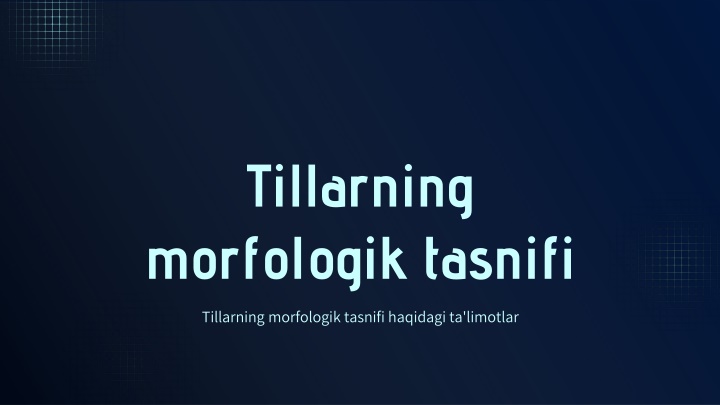
Morphological Classification of Languages: Agglutinative vs. Flektiv
Dive into the morphological classification of languages through the distinctions between agglutinative and flektiv languages. Discover how words are formed, the complexities of their structures, and their unique features in contributing to linguistic richness.
Uploaded on | 0 Views
Download Presentation

Please find below an Image/Link to download the presentation.
The content on the website is provided AS IS for your information and personal use only. It may not be sold, licensed, or shared on other websites without obtaining consent from the author. If you encounter any issues during the download, it is possible that the publisher has removed the file from their server.
You are allowed to download the files provided on this website for personal or commercial use, subject to the condition that they are used lawfully. All files are the property of their respective owners.
The content on the website is provided AS IS for your information and personal use only. It may not be sold, licensed, or shared on other websites without obtaining consent from the author.
E N D
Presentation Transcript
Tillarning morfologik tasnifi Tillarning morfologik tasnifi haqidagi ta'limotlar
Ta'rifi Agglutinative languages are those in which words are formed by stringing together a series of affixes to express grammatical relations. Each affix represents a specific grammatical function, and they can be added in a linear manner without altering the root word.
Xususiyatlari Key features of agglutinative languages include a high degree of morphological complexity, clear syllable structure, and the ability to form long words. Examples include Turkish and Finnish, where affixes articulate tense, number, and case distinctly.
Misollar Examples of agglutinative languages are Turkish, Finnish, and Japanese. In these languages, multiple morphemes combine to form words with varying meanings. For instance, in Turkish, the word 'evlerimizde' translates to 'in our houses', showcasing prefixes and suffixes that modify the root 'ev' (house).
Ta'rifi Flektiv languages, or fusional languages, are characterized by the fusion of grammatical markers into a single inflection or affix. Unlike agglutinative languages, they may express multiple grammatical categories simultaneously, making their morphological structure more complex. Examples include Russian and Latin.
Struktura The structure of flektiv languages involves the modification of root words by merging prefixes, suffixes, and inflections to denote case, tense, number, and gender. These languages utilize a more compact system, where a single affix can convey multiple grammatical meanings.
O'ziga xos xususiyatlar Distinctive features of flektiv languages include irregular verb conjugations, the presence of gendered nouns, and the use of grammatical cases to indicate relationships between words within a sentence structure. These languages often appear more intricate due to their morphological richness.
Conclusions In conclusion, understanding the morphological classification of languages such as agglutinative and flektiv helps in comprehending their structure and usage. Both types exhibit unique features that contribute significantly to the complexity and richness of human languages.
Thank you! CREDITS: This presentation template was created by Slidesgo, and includes icons by Slidesgo Flaticon Flaticon, and infographics & images by Freepik Freepik
